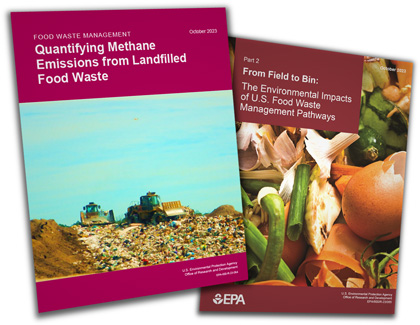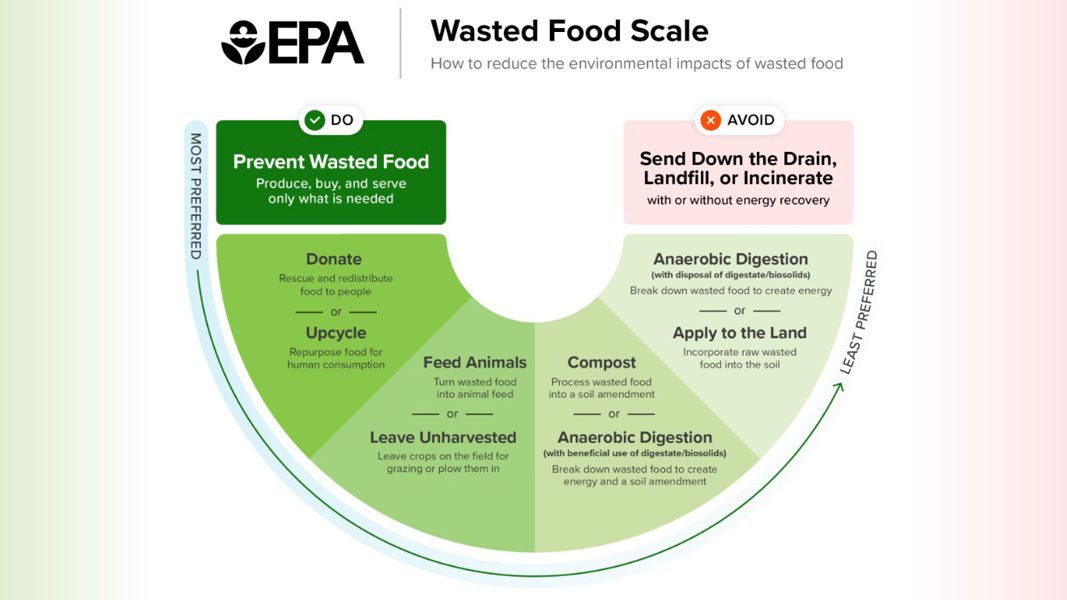Top: The Wasted Food Scale has replaced EPA’s previous Food Recovery Hierarchy.
The U.S. Environmental Protection Agency released two reports on October 19 updating recommendations for managing wasted food and quantifying methane emissions from landfilled food waste. From Field to Bin: The Environmental Impacts of U.S. Food Waste Management Pathways (Part 2) examines the environmental impacts of managing food waste, and completes EPA’s review that began in the 2021 companion report, From Farm to Kitchen: The Environmental Impacts of U.S. Food Waste (Part 1), which analyzed the environmental footprint of food waste in the farm to consumer supply chain. Part 2 synthesizes the latest science on the environmental impacts of how food waste is commonly managed in the U.S. Quantifying Methane Emissions from Landfilled Food Waste presents EPA’s first ever published modeled estimates of annual methane emissions released into the atmosphere from landfilled food waste.

U.S. EPA released two reports: “Quantifying Methane Emissions from Landfilled Food Waste” and “From Field To Bin: The Environmental Impacts of U.S. Food Waste Management Pathways” (Part 2).
From Field To Bin presents a new Wasted Food Scale, an EPA graphic tool to help decision makers understand the best options for managing food waste in terms of environmental impacts. The release of the new Wasted Food Scale marks the first update of EPA’s previous Food Recovery Hierarchy since the 1990s, reflecting the latest science, more recent technological advances, and changes in operational practices. Wasted food is defined in the report as food meant for human consumption but not ultimately consumed by humans. Eleven common wasted food pathways are examined: source reduction, donation, upcycling (i.e., repurposing wasted food into new food for human consumption), animal feed, anaerobic digestion, composting, controlled combustion (i.e., incineration), land application (i.e., applying raw wasted food to soil), landfilling, sewer/wastewater treatment (i.e., sending wasted food “down the drain”), and unharvested/plowed in (i.e., leaving crops in the field). The new scale raises the ranking of composting, and includes new pathways, such as the sewer/wastewater treatment, which shares the lowest ranking with landfilling and incineration. EPA’s research confirms that preventing food from being wasted in the first place, or source reduction, is still the most environmentally beneficial approach.

EPA’s research confirms that preventing food from being wasted in the first place, or source reduction, is still the most environmentally beneficial approach. Photo by Doug Pinkerton
Part 2’s conclusions include:
- The benefits of pathways beyond source reduction, donation, and upcycling are small relative to the environmental impacts of food production, thus, they can do little to offset the environmental impacts. For example, anaerobic digestion can produce more energy per unit of wasted food than the other energy-producing pathways considered in this report (i.e., controlled combustion and landfill), but anaerobic digestion can recover only around 20% of the energy that was required to produce each unit of food.
- Sewer/wastewater treatment and landfilling stand out for their sizable methane emissions. Sewer transport allows for uncontrolled methane releases and wasted food at landfills begins to decompose prior to capping and placement of landfill gas capture systems.
- Recycling wasted food into soil amendments offers opportunities to make long-term improvements in soil structure and health and help regenerate ecosystems by recovering nitrogen and carbon and returning them to the soil.
- As the U.S. becomes less dependent on fossil fuels for energy, the environmental value of producing energy from wasted food will decrease.
The second report, Quantifying Methane Emissions from Landfilled Food Waste, is based on an EPA analysis to estimate annual methane emissions from landfilled food waste from 1990 to 2020. The analysis found that while total emissions from MSW landfills are decreasing, methane emissions from landfilled food waste are increasing — 58% of methane emissions released to the atmosphere from MSW landfills are from food waste. “As the findings indicate, food waste has an outsized impact on landfill methane emissions due to its relatively quick decay rate,” states the report’s Executive Summary. “Since 50% of the carbon in food waste is degraded to landfill gas within 3.6 years, improving gas collection system efficiency in later years cannot substantially reduce these emissions. An estimated 61% of methane generated by landfilled food waste is not captured by landfill gas collection systems and is released to the atmosphere. This data confirms that diverting food waste from MSW landfills is an effective way to reduce emissions of methane, a powerful greenhouse gas.”
Related key findings also are revealing — and build the case for avoided landfill methane emissions by recycling organics, especially food waste:
- In 2020, food waste was responsible for approximately 55 million metric tons of CO2 equivalents (mmt CO2e) emissions from U.S. MSW landfills.
- For every 1,000 tons (907 metric tons) of food waste landfilled, an estimated 34 metric tons of fugitive methane emissions (838 mmt CO2e) are released.
- Reducing landfilled food waste by 50% in 2015 could have decreased cumulative fugitive landfill methane emissions by approximately 77 mmt CO2e by 2020, compared to business as usual.














